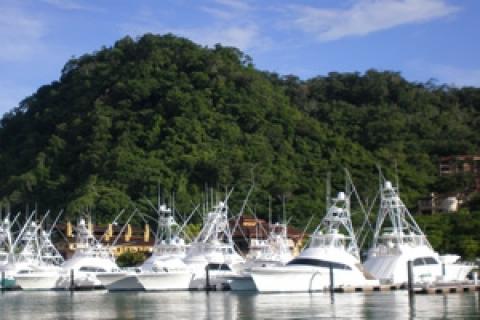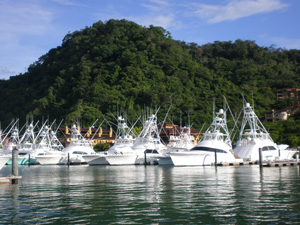
There are many exotic angling destinations in the Western Hemisphere, yet there are few that offer the multitude of habitats, geography, fisheries, and broad socio-cultural spectrums that Costa Rica does possess. Where else can you find a country with an Atlantic mangrove jungle coast featuring surf, inlets and rivers with hordes of tarpon, two kinds of snook and a lush mountainous Pacific coast that teems with roosterfish, black snook, snapper, mahi, tuna and marlin along with some of the world's best surfing? Couple this with lush jungles, volcanoes, white sand beaches with bikinied beauties, robust nightlife, diverse and delicious cuisine, topped off with the strongest safety statistics and environmental preservation in Central America. It's easy to see why traveling anglers and their friends and families love Costa Rica!
 The natives of Costa Rica — known as Ticos — express all their land's beauty and positivity with the salutation and expression "Pura Vida", or Pure Life. This pulsing energy brought me back once again for another angling adventure along the majestic Pacific coast of this sweet country.
The natives of Costa Rica — known as Ticos — express all their land's beauty and positivity with the salutation and expression "Pura Vida", or Pure Life. This pulsing energy brought me back once again for another angling adventure along the majestic Pacific coast of this sweet country.
I was in the mood to experience this paradise at a five-star destination, and for anglers traveling to this region this inevitably would mean Los Suenos Resort and Marina. I had my entire trip arranged and handled by Stay in Costa Rica. My research indicated that this firm was one of the premier operators for vacations, luxury home, villa and condo lodgings, activities, and amenities at Los Suenos. Further, their firm was known for its service-conscious approach with customers and 10 years of success to back up their claim that they'll do whatever they can to give customers a memorable, tailor-made experience.
They arranged for photographer Art Blank and I to stay at the exquisite BellaVista villas. This section of Los Suenos was close to the marina where our chartered boat, "Sunny One" — a 32-foot Maverick captained by Walton Smith — was moored. We also would have use of their championship golf course, Beach Club, Marina Village as well as the clubs and restaurants of the Marriott Hotel.
After the "what" and "where" of the trip was decided, I solved the "when" by choosing July as the month when the greatest numbers of nearshore light tackle gamesters were seasonally present. Ideally, this would include big snook, scrappy roosterfish, slab-sided snapper, jacks, bonito, as well as mackerel. There might even be a chance at some gaffer-sized mahi that were drawn to the inshore flotsam.
Up and Away
Our flight from Miami to San Jose was on time, smooth in ride and services, and just under three hours. We had arranged in advance to be picked up at the airport by the Stay In Costa Rica's transfer vehicle, since the trip would be a scenic 1 1/2 — hour ride through the mountains to the Pacific cove where Los Suenos was situated.
When we passed through the airport's sliding doors into the transportation area, we soon spotted a shiny SUV with our names placarded against its' shotgun window. Though we were originally expecting a regular driver, we learned by phone the day before the trip that Stay in Costa Rica president and owner Larry Savage would be at the helm of the transfer vehicle. I was excited after Larry told us that our drive would feature scenic stops on misty mountains, lush fruit markets, friendly townships as well as his own narrative about the country, the people and his own operation.
The drive to Los Suenos became a merry-go-round of strong, rich images — drinking coffee at a mountainside bar surrounded by a mystical white mist, watching leaf cutter ants ply their way up a tree trunk with their vegetable sails, slowly perusing long, almost voluptuous fruit stands with a staggering variety of colors and shapes, and ending in a slow descent to the indigo shore side cradle where Los Suenos lay in the distance like a reigning tropical king.
After we got settled into our striking three-bedroom villa, Larry picked us up to have dinner in the nearby seaside town of Jaco. We dined at the Hotel Poseidon restaurant. I chose the macadamia-encrusted yellowfin tuna and basmati rice. My entree was excellent as were the Margaritas. Though the nightlife was swirling around us with all kinds of entertainment, Art and I reluctantly chose to "pack it" since we had an early start on the Sunny One next morning.
Time to Fish
After a refreshing sleep and sumptuous breakfast, we went down to the marina at 8 a.m. The Sunny One was brisk with prepatory activity — Captain Walton Smith checking instruments on the flying bridge above and mate Jose organizing the cockpit below. After we came aboard and said hello, Walton mentioned that he was aware from the staff at Stay in Costa Rica that our venue was to be light tackling for inshore gamesters. He pointed to the gleaming tackle and specified that the 12-pound spinning would be for large jacks and bonito, the 20-pound conventional outfits would be for roosterfish and any slammer dolphin encountered, but that the "Terminator"-looking, beefed-up 50-pound outfits would be the lightest we could go for snappers that sometimes pushed 70 to 100 pounds!
Art and I both wanted roosterfish, so Walton crafted a plan that reflected the latest reports of the best fishing for these beautiful battlers: this would involve a run of about an hour across open waters to the rocky shorelines of Tortuga Island. After we made our jaunt across waters that teemed with large schools of small baits, Walton slowed his vessel as we approached the rocky shores of the island. Jose took out some 10-pound spinning rods sporting long Sabiki rigs and told us to cast towards the rocks. In a very short time, the rods heeled over under the weight of double and triple-headers of small blue runners. Jose was quite pleased with the results and had us fill their huge livewell with about 50 of the baits.
When the bait gathering was over, Jose told us that the method of choice for safely and effectively pursuing roosters along the rocks was slow trolling. He then rigged up four 20-pound outfits with bridled double-hooked live baits. Two of the outfits were mounted on transom holders and two were mounted on flying bridge receptacles. Not surprisingly, each bait was fished at a different distance to achieve an enticing and effective "spread". And, so, we began our trolling along the rocks of Tortuga Island amidst seas that hissed and splattered into white foam when the waves of the Pacific struck the island's granite shore.
I am sure that Jose sensed that he was dealing with "restless trollers" when we mentioned that we were casters at heart. Wisely, he removed an ice-cold pineapple from their refrigerator and used his rapid knife-skills to serve up succulent juicy yellow snacks to soothe the nerves of these light tackle brats.
It wasn't long before one of the transom rods doubled over under the weight of an obviously big fish. I grabbed the outfit out of the holder and struck hard...one, two, three times. The line continued flying off the drag and angled downward towards the rocky bottom. Walton shouted from above, "big snapper" and headed the vessel away from the shoreline towards the open Pacific in an effort to keep the line away from the sharp undersea rocks. After about 15 seconds, my rod suddenly popped up straight, signifying a cut-off.
Since there were possibly more huge snapper around, Walton and Jose reluctantly but realistically swapped out the rods to the heavier 50-pound rigs. Within a half-hour, the beefy rod on the starboard transom "went off" as its line sizzled towards the bottom. Art struck the fish and held the rod high to keep a huge amount of pressure on the fish. Yet even the "Terminator" outfit could not stop this ATV-sized bully from finding the bottom and cutting us off.
In two more hours, the same scenario happened another frustrating six times- it was clear that any roosters in the area were either reluctant to strike and/or were being beaten to the live baits by big bad snappers. I called a huddle and we decided to work away from the island and do some running and gunning on the bait schools in the open water. We were rewarded with lots of bonito and mackerel on small trolled feathers as well as balao. The hours of our fishing passed quickly. As we headed to the marina, we made plans to "fish the shrimp boats" five miles west of Los Suenos the next day.
Fishing, Day Two
After we idled out of the marina, Walton ran the Sunny One roughly westward along the shoreline until we saw silhouettes of shrimp boats on the horizon. As he throttled down to trolling speed, Jose deployed two spinners with large-lipped orange-colored Rapala-style plugs and mounted them on the transom holders. He rigged another two 20-pound conventional outfits with balao and set them off of the outriggers. When all the baits were positioned in a well-orchestrated troll, Walton called down from the bridge, "When we get near the shrimp boats, get ready for action!"
As we trolled towards the vessels, their enlarging shapes and growing detail showed us that some "spread-eagled" boats were dragging for shrimp while other boats were drifting as they culled out their bycatch. The good news was that there were circling, wheeling, and diving birds everywhere.
Walton pointed the Sunny One towards a "culling boat" as he shouted down over the engines that the vessels with dropping bycatch would have the most gamefish below. As we got within 100 feet of the vessel, 3 of the 4 rods went off- Art, Jose, and I grabbed the rods and were hooked up to what would be 2 big jacks and a fat bonito. The rest of the fishing day became an orgy of abundance that would rival Adam Richman's Man versus Food. The gamesters kept coming every time we trolled near the shrimp boats- any of them! While the bulk of the catch were big jacks, bonito, and mackerel, my favorite(s) were the huge houndfish that were hitting the balao baits. Some of these javelin-shaped, needle-toothed predators were almost five feet long and fought like small sailfish.
As our day neared an end and we traveled back to Los Suenos, I called Larry Savage on my cell phone to thank him for arranging such great fishing, lodgings, and amenities. As we rounded the last set of rocks and the marina came into view, I could well appreciate that Costa Rica loosely means "rich, fine coast"- and it certainly was!
Important facts about Costa Rica
- Capital: San Jose
- Population: 4.5 million residents
- Size: 23,000 square miles or about the size of West Virginia.
- Climate: subtropical
- Electrical Voltage: 110; same as U.S.
- Monetary Unit/Values: Colon at 515 to $1; the dollar is widely accepted.
- Entry Requirements: Foreigners need a valid passport and are allowed to stay 90 days without a visa or vaccination requirement.
- Departure Tax: Approximately $26
- Language: Spanish, although English is the unofficial second language.
- Transportation: Many major American cities-such as Miami-have direct flights to San Jose.
- 4219 views

